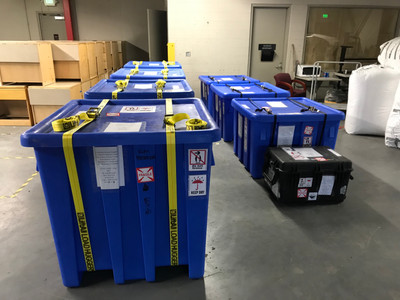Our team leaves for Antarctica in a little over 2 weeks. We have been preparing for this expedition for months now. As the Principal Investigator on this US National Science Foundation funded project, I began planning the logistics for this expedition before I had even been awarded the grant. In fact, I had to include some of the logistics in my grant proposal, so really, I've been planning this for a long, long time.
There is a huge amount of planning that goes into an expedition of this nature. Thankfully, the US Antarctic Program and the Antarctic Support Contractors do most of the major logistically challenging planning and make sure that the scientists can be successful in their research.
Some of that planning includes providing detailed lists of our needs while in Antarctica ~ this includes scientific equipment needs, cargo requirements, lab space needs, and so on. We will be based at Palmer Station, the smallest of three US Antarctic Program stations. Palmer Station is extremely well-equipped for science and is a fantastic place to conduct research.
Despite the long lists of available scientific equipment and supplies available at Palmer Station, many scientists must still bring their own gear. The largest items we have shipped down to Palmer Station are sixteen 200L tanks that we will use for live experiments on Antarctic krill. Those have all been shipped, first from Corvallis to Port Hueneme (California) and then on to Punta Arenas, Chile. In total, we shipped 7 large containers with research equipment and tanks. We also had to design the plumbing system for these tanks. This was a fun challenge and I'll post more about that in the coming weeks.
In addition to shipping cargo and requesting research instruments and consumables, we all have to go through a series of rigorous medical and dental exams. This is called the PQ process - PQ means physically qualified (there are a lot of acronyms in this business). Palmer Station is a remote location and access to medical facilities is extremely limited. A medical emergency evacuation would not happen quickly and so it is essential that anyone planning on spending time at Palmer Station (or any of the other US Antarctic Program stations) is physically qualified to do so. Thankfully, our team has been PQ'd and we're good to go!
On top of the logistics involved with the research, each of us needs to pack enough warm clothing and everything else we might need for 6 months in the Antarctic winter! I've been asked by many of my friends and family what I will pack for this expedition. So I thought I'd share my packing list in the form of one of those fun clothes-on-the-floor photographs. Of course, there will be more socks than just the one pair photographed. And I do plan to take underwear. And this pile doesn't include my supplements, medication, and toiletries. Nor does it include all of my gadgets and other fun things.






Comments